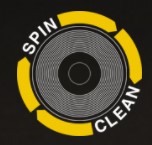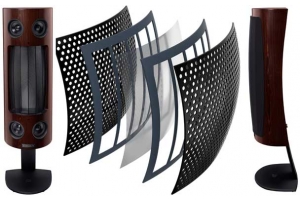Nous utilisons des cookies pour améliorer votre expérience. Pour respecter la nouvelle loi en vigueur, nous devons vous demander votre consentement pour le dépôt de cookies. En savoir plus
Sound and Music
Sound and Music
Sound and Music
How is Sound perceived ?
In a human being, sound is captured by the ear and sent to the brains as nerve ( electrical ) signals. It is the biological equivalent to a microphone.
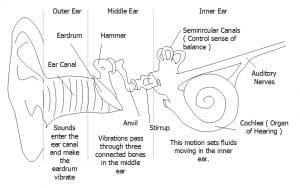
From the outer ear ( pinna ) sound waves travel through the ear canal to reach the eardrum and cause it to vibrate. In turn, the eardrum cause three ossicles to vibrate – the hammer, the anvil and the stirrup, which make up a mechanical amplifier. The stirrup connects to the oval window, which is a thin membrane covering the entry to the cochlea, that converts mechanical vibrations into electric nerve impulses transmitted to the brain by means of the auditory nerves.
What is the Frequency Response of the Ear ?
Not only is the ear’s frequency response not flat – it is more sensitive to the mid-frequencies – but it also changes with sound intensity. Reaserchers Kingsbury ( 1927 ), Fletcher and Munsen ( 1933 ) and then Robinson and Dadson ( 1956 ) developped the Fletcher Munsen Equal Loudness Curves to quantify this phenomenum.
These curves are obtained by subjecting a listener to tones of various frequencies. The tone intensity is adjusted so the listener hears them at the same loudness. The consequence of all this on sound reproduction is that the relative intensity at different frequencies changes with volume. This explains why listening at low volumes sounds « thinner » than listening at higher volumes. This also explains why standard studio listening level is 80 dB SPL.
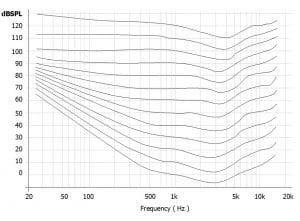
What about frequency and music ?
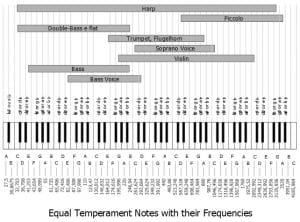
How does Sound Propagates ?
What is Inverse Square Law ?
The further from the source, the weaker the sound. This weakening follows the « Inverse Square Law » which states that intensity reduces to the square of distance between source and listening point. Thus, if the listening distance doubles, sound gets 75% weaker. This is attributable to the sound wave propagating in a sphere like fashion. Doubling the radius of a sphere quadruples its surface.
So for a loudspeaker producing 90 dB SPL 1 meter away, sound intensity will be 84 dB SPL 2 meters away or 6 dB less ( ¼ ). This here is a theoretical value since other factors may influence sound propagation, such as reflections on walls and ceiling, for instance.
What is Sound Reflexion ?
Just like light on a mirror, sound reflects on different surfaces. These reflections can be long or short in time. A long time reflexion will late enough to cause an echo. Short time reflections ( reverberation ) affect the perceived sound ; a listening environment with little or no reflections will be called « dead » or neutral, as a listening environment with more reverberation will be called « live ». Undesirable reverberation can affect sound to the point of making it objectionable.
What is Acoustic Absorption ?
The contrary to reflection is absorption. An acoustical absorption material is like a black color surface not reflecting light. Le contraire de la réflexion est l’absorption.
What are Acoustic Standing Waves ?
One unwanted effect of reflections is the so-called « standing waves ». Those stationary waves are produced when sound is reflected by a surface in a room with at least two parallel walls in between which there is at least a wavelength multiple distance. The reflected wave adds up or is subtracted to the incident wave along the sound path, with effects on the frequency content of sound according to the listening point location.
Then, one would hear not enough or too much bass depending on the listening position in the room. Standing waves can be alleviated by acoustic absorbants or when building the room. This is why recording studios are often built in irregular shapes.
What is Doppler Effect ?
Waiting at the railroad crossing, the train horn seems to change pitch. It increases coming in and decrease going away. This is because the train moves and the listener does not. The sound wavelengths contract coming in and extend going away. This is the Doppler Effect. The train driver hears no pitch change.
What is Safe Listening ?
Medias and health care practicioners talk regularily about hearing loss caused by excessively loud noises or listening to music at high volume. State authorities in charge of health and safety in the workplace have define acceptable levels, and especially the duration of sound exposure, since the effects of loud sound exposure cumulate with time. For example, at 80 dBA, there is no problem even for several hours. For 90 dBA, one should not exceed 4 hours per 24 hours, for 100 dBA 24 minutes per 24 hours and no duration at all beyond 120 dBA.
The dBA is a weighted version of the dB SPL. The weighting corresponds to the inverse of the Fletcher-Munsen curve that intersects 40 dB SPL at 1 kHz.
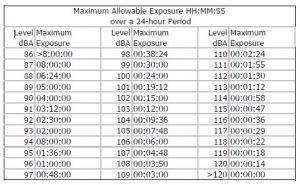
References<//h3>
https://commons.wikimedia.org/wiki/File:Oreille-Audition.jpg, Merck Manual of Medical Information, second Home Edition , Pocket Books 2003, page 1135
https://en.wikipedia.org/wiki/Equal-loudness_contour
Tremaine, Howard M. - Audio Cyclopedia Second Edition - Howard W. Sams, 1977 : the first two sections, pages 11 to 99, are very resourceful on the subject of sound.
https://en.wikipedia.org/wiki/Inverse-square_law
https://en.wikipedia.org/wiki/Doppler_effect
Safe Listening Levels from Government of Canada, SOR/DORS*91-448 july 1991
These often refer to Wikipedia sources for convenience. Wikipedia articles mention other sources that may be useful to the reader that wants to further research the matter. A word of caution though : since Wikipedia is a collaborative encyclopedia, anyone can modify an article ; reasonable skepticism is thus recommended.





